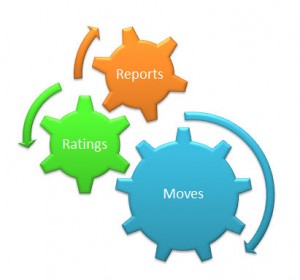 Big institutions have been using prospect research long before the internet turned the field upside down. Those institutions still lead the way in things like database analysis, multi-channel direct appeals, multi-million dollar gifts and multi-billion dollar campaigns. Big is nice, but if you’re not that big, how can you be sure prospect research will work for your organization?
Big institutions have been using prospect research long before the internet turned the field upside down. Those institutions still lead the way in things like database analysis, multi-channel direct appeals, multi-million dollar gifts and multi-billion dollar campaigns. Big is nice, but if you’re not that big, how can you be sure prospect research will work for your organization?
Here are ten things you should know as you evaluate what type of prospect research will work for you.
(1) In-person research is a must
As a front-line fundraiser talking directly with donors, you are responsible for some of the most important prospect research your organization can do! You are the one who gets to ask donor prospects questions about why they give, what they love about your organization, what is going on in their family and so many other crucial questions.
Example: A donor prospect can look great on paper, until you visit and discover that the child has special needs, aging parents have run out of money for care and the wife has just cut her career back to care for family.
(2) Google really is good
Google and other search engines are an incredible source of information. Learning how to use search engines effectively has become a life skill. As a front-line fundraiser, you should be able to quickly find some basic information on your donor prospect. However, you will short change yourself and your organization if you do not get professional prospect research before asking for a major gift of $10,000 or more.
Example: A fundraiser had been engaging a donor for years and he was now on the board of trustees. When they were planning a campaign, she asked for an in-depth profile to help decide the size and type of leadership gift he might be capable of. Research discovered significant commercial real estate investments unrelated to the prospect’s primary business. The fundraiser was able to ask another board member who had made complex real estate gifts, to help cultivate and solicit.
(3) Peer Review has pros…and cons
Peer review – asking a select group of volunteers to review and rate prospects – can help you uncover personal information about prospects that formal research does not find, including great insights into a prospect’s personality. But we’ve all known prospects who impress people as wealthy when really they carry a lot of debt or still rely on money from their wealthy families. Peer review is one piece in the prospect puzzle, not the whole picture.
(4) Information is always as good as the source
One of the first rules of research is to scrutinize the source of information. Some sources are more reliable than others. It is important to ask your vendor and keep yourself educated on the sources being used in prospect research.
Example: A Google search on your prospect’s name might reveal a bio saying she serves on a local hospital’s board, but does she? Checking the hospital’s website and/or IRS tax form 990 is a better source. Or you could just ask her…(see #1)
(5) Prioritizing is not an exact science
Your organization has done a stellar job of managing its annual appeals and building its database. Now you have to figure out who among the 5,000+ records should receive event invites, specific appeals, or be asked for a major gift. You don’t want to start with the letter “A” and go from there. But recognize that prospect screenings and data mining efforts are not perfect.
Example: Sweet Charity was methodically working through its best-rated prospects from a recent wealth screening when a donor not on their list expressed an interest in a naming opportunity. It turned out that the donor held a middle-class job, but had a large trust fund as an inheritance. He had been well-stewarded by Sweet Charity for five years and when he read about the campaign in the newsletter he wanted to honor his parents.
(6) Donor Giving is Confidential
Every fundraiser is aware that a donor’s gift to your organization is confidential. We know to ask permission before sharing donor names and stories. Keep this in mind as you review results from database screenings and prospect profiles. Prospect research can only find gifts that have been disclosed to the public by the nonprofit or the donor.
(7) Private Companies are Private
Entrepreneurs are a very philanthropic group and usually own and operate one or more private companies. Private means that the shares or ownership of the company are not available to the public for purchase. It also means that the company does not have to share information, such as sales or profits. Really. Sometimes they do share, but most often we have to guess. It also means we don’t know how much of the company they own or what they sold their company for – unless they tell someone. And sometimes they do tell.
(8) Maybe you can find out stockholdings
Unlike private companies, public companies trade their shares with the public. So you might think that if someone owns shares of a public company we could find out, right? Wrong! Maybe we can find out. Stock ownership is reported only if the person is an insider: top executive, director, or owns 10% or more of the company stock. There are exceptions, but not too many.
(9) You get what you pay for
Many organizations want cheap research. Why should you pay a lot of money for research if you are not sure you will even get the gift? Because, when done well, you raise more money. If you know how to use a prospect screening effectively, every area of your fundraising could have improved results. Really, really. And if you hire a professional prospect researcher (i.e., researcher-fundraiser), you will get donor profiles that provide the kind of wealth and giving insights you need to maximize major gifts. Freelancers often don’t have the experience or the paid resources to give you what you need. How committed are you to using the information? Pay accordingly.
(10) Partnering with Prospect Research raises money!
So you invest in serious prospect research, but it still feels generic and not so helpful. Make sure that partnering is part of the purchase. Prospect research is most effective when research can answer a clearly defined question. That means discussing the project before work begins, during and after. Prospect researchers are fundraisers too and we want to raise money – get a “Yes!” – just as much as you do! So let’s talk.
Can you trust prospect research? Absolutely! When you buy quality and use it skillfully, prospect research can make your fundraising efforts SHINE. Are you looking for prospect research solutions for your organization? Contact Aspire Research Group at 727 202 3405 and ask for Jen Filla or email jen at aspireresearchgroup.com or visit us at www.AspireResearchGroup.com.
 Ratings – Each prospect is rated so you can stay focused on those who can help you reach your dollar goal.
Ratings – Each prospect is rated so you can stay focused on those who can help you reach your dollar goal.







